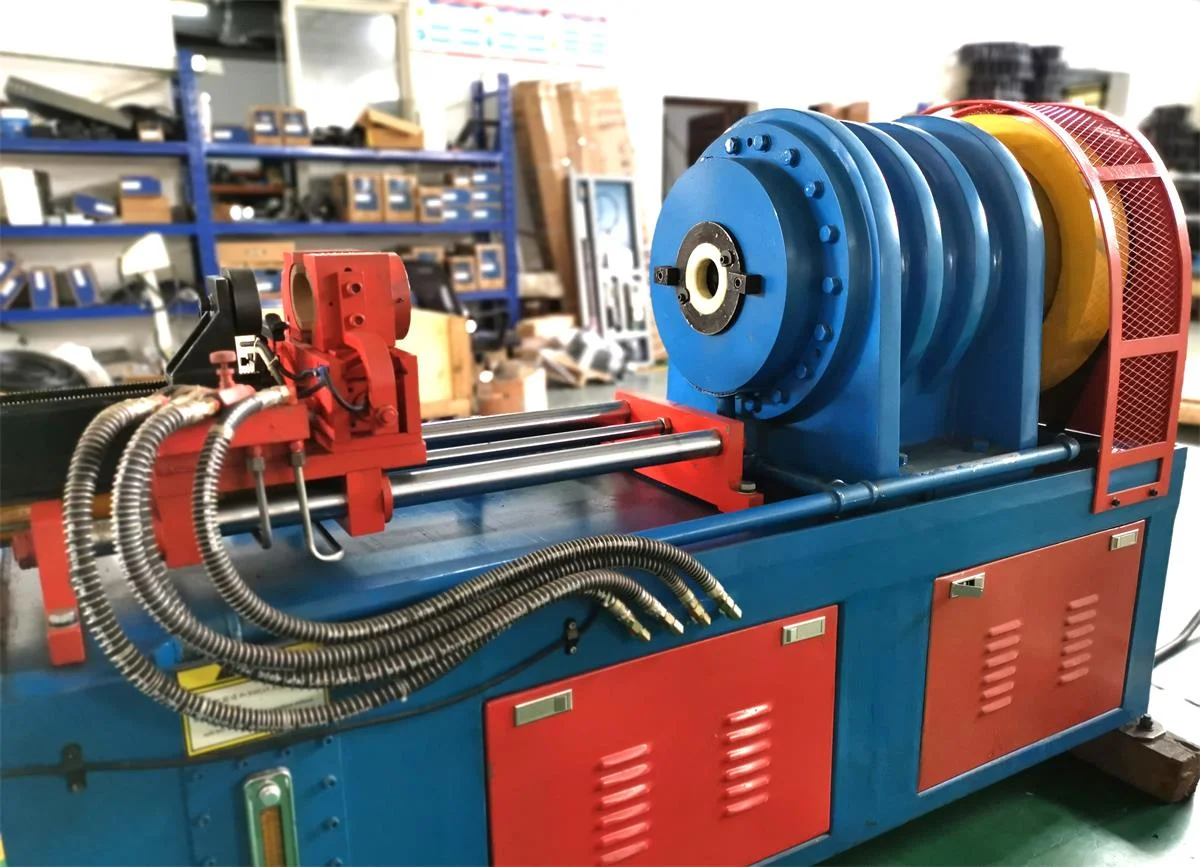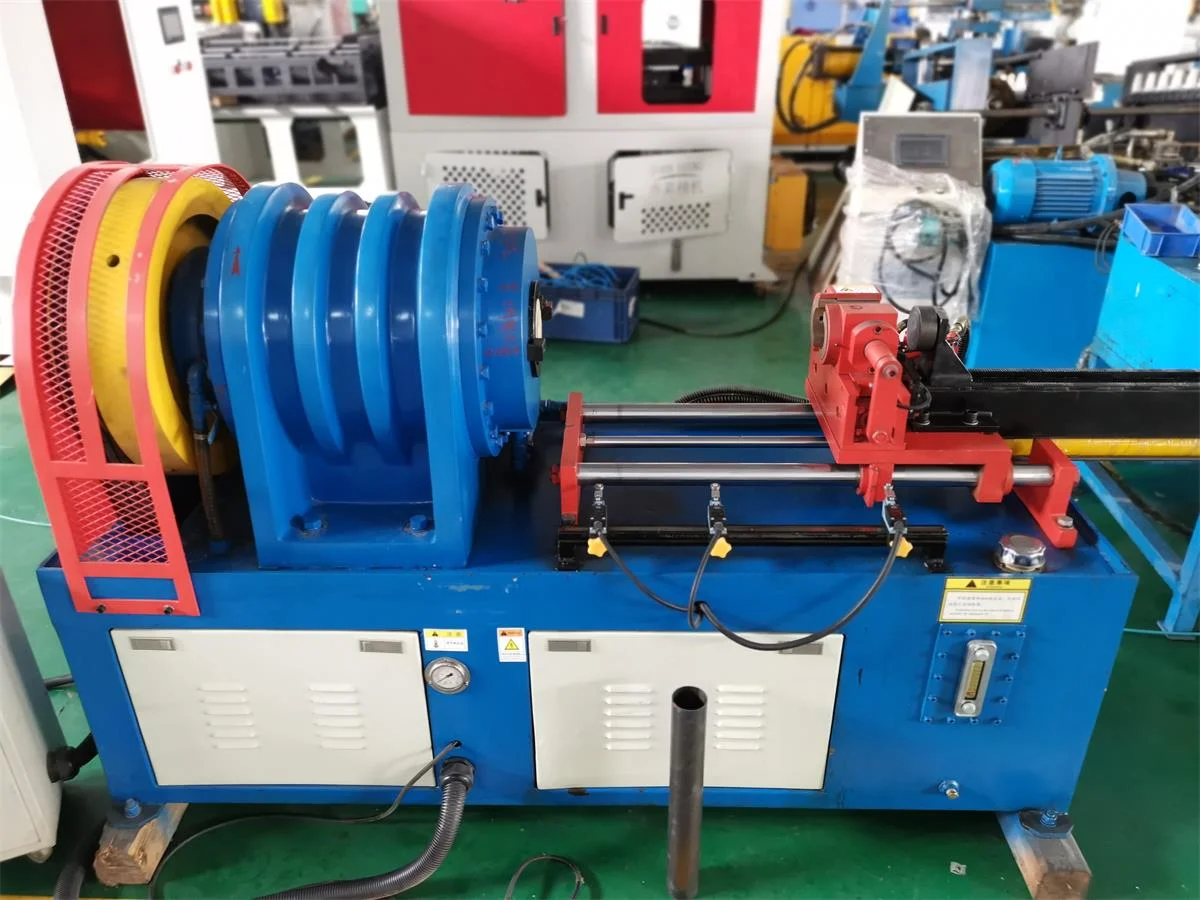Looking to streamline your manufacturing process? A tube end forming machine is the solution you need. Say goodbye to manual shaping and hello to precision and efficiency. Whether you're shaping, cutting, or expanding tubes, this machine offers consistent results every time. Increase productivity while reducing labor costs with this versatile equipment.
Understanding Tube End Forming
Processes Involved
Tube end forming is crucial in manufacturing for shaping the tube ends to meet specific requirements. This process encompasses various techniques such as expansion, reduction sizing, flaring, notching, and shearing.
These methods play a vital role in achieving desired tube end shapes, sizes, and functionalities. For instance, expansion increases the diameter of the tube end, while reduction sizing decreases it. Flaring creates a cone shape at the end for connections, and notching allows tubes to fit together securely. On the other hand, shearing cuts the tube precisely.
Precision and Customization
The precision and customization offered by tube end forming machines are essential for meeting specific industry needs. The ability to control dimensions, angles, and shapes with high accuracy ensures that each tube meets exact specifications.

Types of Tube End Forming Machines
Ram Form
Ram forming machines are versatile and suitable for various tube end forming operations, including expanding, reducing, flaring, and beading. They offer precise control over the forming process.
Vise Ram Form
Vise ram form machines utilize a vise-like mechanism to hold the tube in place during forming. This design ensures stability and accuracy in shaping tube ends.
Tube Parting
Tube parting machines are specifically designed to cut tubes to specific lengths accurately. They are essential for industries requiring precise tube cutting for their applications.
Tube Notching
Tube notching machines are used to create notches or grooves at the end of tubes for welding or joining purposes. They ensure seamless connections between tubes.
Features of Single-Head and Multi-Head Configurations:
-
Single-Head: Ideal for simpler operations, offering cost-effectiveness and ease of use.
-
Multi-Head: Suitable for complex forming tasks, enhancing efficiency by performing multiple operations simultaneously.
Comparison: EcoForm 80 IO vs. eRB80 IO+IO
-
EcoForm 80 IO: Known for its advanced technology and precision in end forming processes.
-
eRB80 IO+IO: Offers dual-head functionality, enabling simultaneous processing for increased productivity.
Applications in Various Industries
Automotive Sector
Tube end forming machines find many applications in the automotive industry for creating precise bends and shapes in exhaust systems and chassis components. These machines play a crucial role in ensuring the structural integrity and performance of vehicles.
Aerospace Industry
In the aerospace sector, tube end forming machines are utilized to fabricate complex end form applications for aircraft hydraulic systems and fuel lines. The accuracy and repeatability of these machines are essential for meeting stringent safety standards.
HVAC and Plumbing
Within the HVAC and plumbing industries, tube end forming machines are instrumental in producing high-quality products such as air ducts, refrigeration components, and piping systems. These machines streamline production processes, resulting in improved efficiency.
Real-World Examples
-
In the automotive sector, tube end forming machines are employed by leading car manufacturers to create custom exhaust systems that meet specific customer needs.
-
Aerospace companies use tube end forming machines to craft intricate fuel line assemblies that adhere to strict industry standards.
-
HVAC companies rely on these machines to produce precise bends in air ducts, ensuring optimal airflow within commercial buildings.
Benefits of Using Tube End Formers
Improved Efficiency
Tube end formers enhance the efficiency of tube end forming processes by automating and standardizing the shaping of tube ends. This automation ensures consistent results every time, reducing errors and rework.
Reduced Material Waste
By precisely shaping tube ends, end formers minimize material waste during the manufacturing process. This accuracy leads to significant cost savings by optimizing material usage and reducing scrap.
Enhanced Product Durability
The use of tube end forming machines results in stronger and more durable tube connections. The precise shaping provided by these machines ensures a secure fit, enhancing product integrity and longevity.
Streamlined Production Workflows
End formers streamline production workflows by expediting the tube end forming process. With faster cycle times and increased throughput, manufacturers can meet production deadlines more efficiently.
Cost-saving Advantages
Investing in tube end formers offers long-term cost-saving advantages for companies. By reducing material waste, improving efficiency, and enhancing product durability, these machines contribute to overall cost reduction in production processes.
Competitive Edge
Companies utilizing tube end forming machines gain a competitive edge in the market. The ability to deliver high-quality products efficiently and cost-effectively sets them apart from competitors, attracting more customers and driving business growth.

Selecting the Right Machine
Tube Diameter Capacity
When choosing a tube end forming machine, consider the diameter capacity it offers. Ensure the machine can accommodate your specific tube sizes.
Tooling Options
Evaluate the tooling options available with the machine. Look for versatility in slotting, ram tool, hole punch, and knurl capabilities.
Technology Options
Consider the technology used in the machine. Decide between servo hydraulic, all-electric, or hybrid machines based on your production needs.
Durability and Precision
Assess the durability and precision of the machine. Look for features like sturdy clamps, precise bending mechanisms, and efficient die sets.
Customization Features
Examine the customization options offered by each machine. Check if you can easily adjust settings to meet your specific application requirements.
-
Pros:
-
Wide range of tooling options.
-
High precision and durability.
-
Versatile customization features.
-
Cons:
-
Initial investment cost may be high.
-
Different technologies require specific expertise for operation.
Maintenance Best Practices
Inspection
Regular inspection of all components is crucial to detect any signs of wear or damage early. Check for loose bolts, worn-out parts, and unusual noises during operation.
Cleaning and Lubrication
Cleaning the machine regularly helps prevent debris buildup that can affect performance. Use appropriate cleaning agents and ensure thorough drying before lubricating moving parts.
Calibration
Calibration ensures precision in tube end forming. Regularly calibrate the machine to maintain accuracy in shaping, cutting, and bending processes.
Checklist for Routine Maintenance
-
Inspect hydraulic systems for leaks or pressure irregularities.
-
Check electrical connections for any loose wires or damaged components.
-
Monitor tooling wear and replace as needed to maintain quality outputs.
Troubleshooting Common Issues
-
Uneven tube ends: Check tool alignment and adjust if necessary.
-
Excessive noise: Inspect bearings and lubricate or replace as required.
-
Inaccurate cuts: Verify calibration settings and adjust accordingly.
Optimizing Production Efficiency
Workflow Automation
Implementing workflow automation in tube end forming machines streamlines processes, reduces manual intervention, and enhances overall efficiency. By automating repetitive tasks such as forming processes and assembly, companies can significantly boost production rates.
Efficient tooling optimization plays a crucial role in enhancing the precision and capability of tube end forming machines. Utilizing advanced tooling technologies ensures consistent quality outputs, minimizes downtime for adjustments, and maximizes the machine's overall performance.
Predictive Maintenance
Employing predictive maintenance strategies allows companies to proactively address potential issues before they escalate, minimizing unplanned downtime and optimizing machine uptime. By leveraging data analytics to monitor equipment health in real-time, organizations can make informed decisions to prevent costly breakdowns.
Continuous improvement initiatives focus on refining processes, enhancing skillsets, and optimizing machine capabilities. Companies that prioritize ongoing training for employees on tube end forming machines witness improved efficiency levels, reduced cycle times, and enhanced product quality.
Case Studies
Companies like XYZ Industries have successfully implemented tube end forming machines with fast chip-to-chip times, enabling them to produce large beads and flares with exceptional precision. This transformation has resulted in a 20% increase in production output and a significant reduction in unit costs.

Closing Thoughts
You now grasp the ins and outs of tube end forming, from its diverse types to the advantages it offers across industries. By selecting the right machine and following maintenance tips, you can optimize production efficiency, boosting your output significantly. Remember, a well-maintained machine ensures seamless operations and prolonged lifespan.
Take action today by implementing these insights into your tube end forming processes. Enhance your productivity, reduce downtime, and improve overall product quality. Stay informed about the latest advancements in tube end forming technology to stay ahead in the competitive manufacturing landscape.
Frequently Asked Questions
How does tube end forming contribute to manufacturing efficiency?
Tube end forming streamlines production by shaping and finishing tube ends quickly, reducing manual labor and ensuring precise results. This process enhances the overall efficiency and quality of various manufacturing operations.
What are the key benefits of using tube end formers in industrial applications?
Tube end formers offer increased productivity, cost savings, improved accuracy, and enhanced safety in industrial settings. They enable consistent shaping of tube ends for diverse applications across industries.
How can one select the right tube end forming machine for specific needs?
Consider factors like production volume, material type, required end forms, and available space when choosing a tube end forming machine. Consult with experts to ensure the selected machine aligns with your specific requirements.
Why is regular maintenance crucial for tube end forming machines?
Regular maintenance ensures optimal performance, prolongs machine lifespan, prevents breakdowns, and maintains product quality. Following recommended maintenance practices will help maximize the efficiency and reliability of your tube end forming equipment.
In what ways can production efficiency be optimized when using tube end formers?
Optimizing production efficiency involves proper training for operators, implementing preventive maintenance schedules, utilizing advanced technologies, and continuously monitoring performance metrics. These strategies enhance output quality while minimizing downtime in manufacturing processes.
The Role of Automatic CNC Pipe End Forming Machines in Modern Manufacturing
John Sheng
Johnsheng.cn@gmail.com

